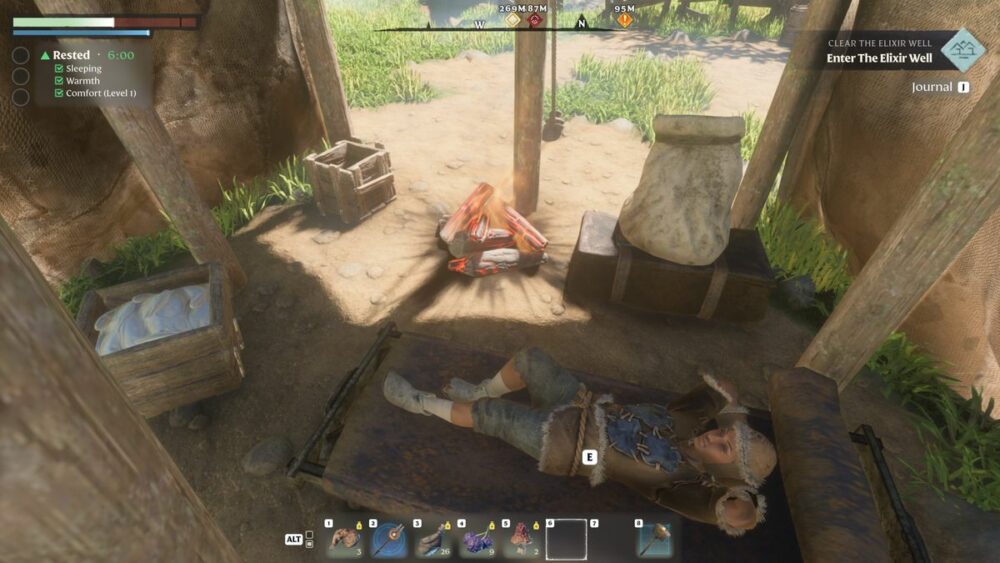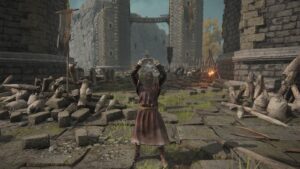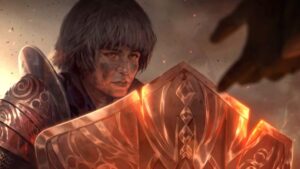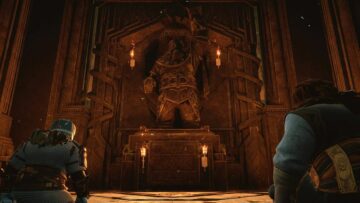Enshrouded, now in early access, is similar to other open-world survival games you’ve probably played before. It has a post-apocalyptic fantasy storyline, tons of trees to hit, and crafting that’ll let you build a home where you can store the endless resources you’ll pick up. Its biggest flaw right now is that it doesn’t have much of a unique identity, minus the “shroud” that will kill you if you spend too long inside it. That said, with exploration, crafting, and one of the easiest settlement-building systems I’ve ever used, Enshrouded is a good time.
However, there’s one thing that separates Enshrouded from the rest of the super-popular early access survival games out right now, and that’s sleep. You’ve likely encountered a sleep mechanic in games before — Bethesda games often allow you to heal up and pass time while sleeping, for example — but Enshrouded ties it into your grand strategy in a way that’s both easy to understand and more complex if you want to take full advantage of it. It’s not just about resting; it’s about getting a good night’s sleep.
The resting buff provides you with higher max stamina and regeneration for a period of time decided by your level and the comfort of the area around you. To get the most out of your sleep, you’ll need three things. First, you need to be under shelter, which could mean hopping into a tent, building a roof on your home, or using your pickax to make a hovel inside a boulder. Second, you need to be warm, so craft a campfire and get cozy. Finally (and most importantly), you need to be comfortable. You can’t sleep on the cold, hard ground in Enshrouded, but you can find empty cots as you explore and eventually build your own. The more furniture a shelter has, the more comfortable you’ll be.
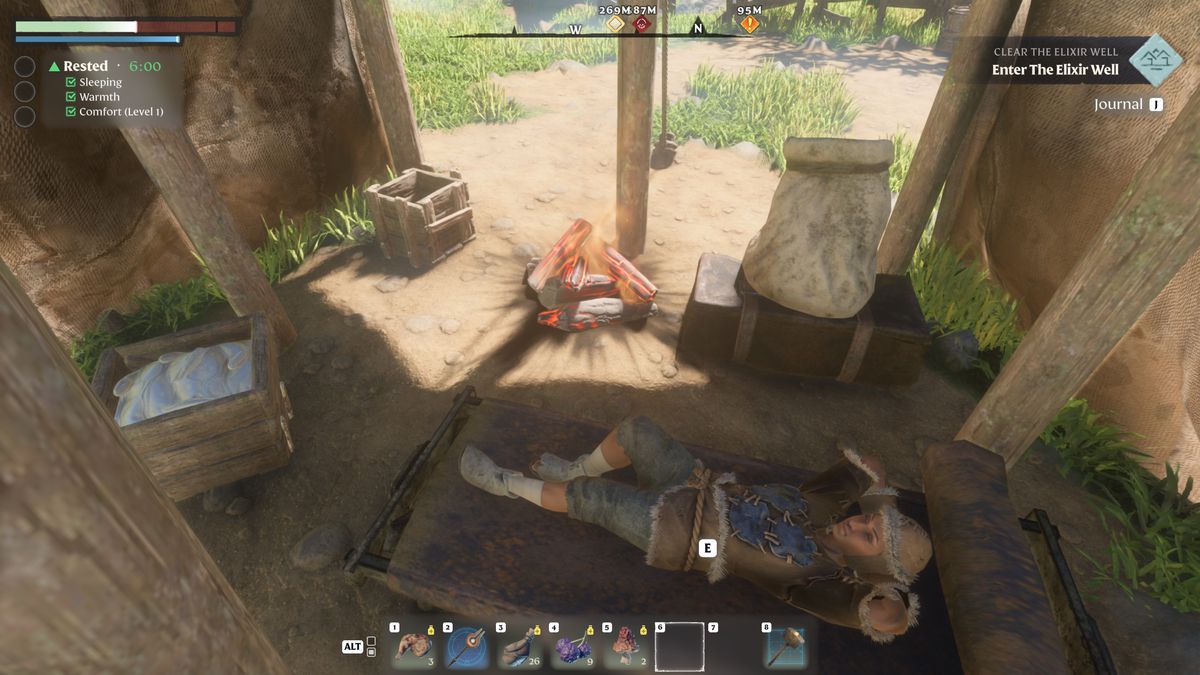
The higher your level, the longer you can stretch out the buff. Granted, it takes a long time to level up in the early parts of the game, but even just a few minutes can make a difference. Ticking all three boxes gets you the biggest rest buff, but you can still reap some benefits if you just tick one of the boxes. So if you happen to have a roof over your head, you’ll still get a small stamina buff. It won’t last as long, but if you’re trying to run away from enemies or get through the Shroud, any stamina boost is worth looking for.
Plus, if you can get to sleep during the nighttime, the game will run at 60 times the regular speed. Considering the world of Enshrouded is dark and navigating the land is nearly impossible at night, it’s always helpful to use this feature if you can.
Valheim is another early access survival game that has a similar resting buff: Sit down next to a fire or rest in a bed and you’ll get a boost to both health regeneration and stamina regeneration. Enshrouded’s buff works better in that it’s much easier to figure out, thanks to the game’s simple UI. In Valheim, there are technically two buffs you can get from relaxing, and what you get from each is a bit complicated to understand (unless you like doing math). With Enshrouded, you just have to look at how long the buff lasts. The higher your level and the better your comfort, the longer it’ll last. I’ve seen people online get it to last a full hour, although the most I’ve gotten was around 20 minutes.
Enshrouded has a lot of subtle but effective limitations on crafting and exploration that are designed to keep you endlessly collecting resources and exploring. While this can be frustrating for people used to just going out and letting their pickax fly for hours, it does implement some tension that forces you back to your home to get some other work done. This can be circumvented by leveling up to some extent, but for most players just starting out, they’ll have to get a good night’s rest frequently. And it’s worth it.
- SEO Powered Content & PR Distribution. Get Amplified Today.
- PlatoData.Network Vertical Generative Ai. Empower Yourself. Access Here.
- PlatoAiStream. Web3 Intelligence. Knowledge Amplified. Access Here.
- PlatoESG. Carbon, CleanTech, Energy, Environment, Solar, Waste Management. Access Here.
- PlatoHealth. Biotech and Clinical Trials Intelligence. Access Here.
- Source: https://www.polygon.com/gaming/24055526/enshrouded-sleep-mechanic
- 20
- 60
- a
- About
- access
- ADvantage
- All
- allow
- Although
- always
- and
- Another
- any
- ARE
- AREA
- around
- as
- At
- away
- back
- BE
- before
- benefits
- Bethesda
- Better
- Biggest
- Bit
- Boost
- both
- buff
- build
- Building
- but
- by
- CAN
- character
- cold
- Collecting
- comfort
- complex
- complicated
- considering
- corner
- could
- craft
- crafting
- decided
- designed
- difference
- does
- doing
- done
- down
- During
- each
- Early
- early access
- easier
- easiest
- easy
- Effective
- Endless
- Endlessly
- even
- eventually
- EVER
- Example
- exploration
- explore
- Exploring
- extent
- FANTASY
- Feature
- few
- Figure
- filled
- Finally
- find
- Fire
- First
- flaw
- Fly
- For
- forces
- frequently
- from
- frustrating
- full
- furniture
- game
- Games
- Gaming
- Get
- gets
- getting
- going
- good
- grand
- granted
- Ground
- happen
- Hard
- has
- Have
- head
- Health
- helpful
- higher
- HIT
- Home
- hour
- hours
- How
- HTTPS
- Identity
- if
- implement
- importantly
- impossible
- in
- INSIDE
- into
- Is
- IT
- ITS
- jpg
- just
- keen
- keep
- Land
- last
- left
- let
- Level
- level up
- like
- likely
- limitations
- Long
- longer
- Look
- looking
- lot
- make
- math
- mean
- minutes
- more
- most
- much
- Navigating
- nearly
- need
- Next
- Night
- not
- now
- of
- often
- on
- One
- online
- or
- Other
- out
- over
- own
- parts
- pass
- People
- period
- pick
- plato
- plato data intelligence
- platodata
- platogaming
- played
- player
- players
- Polygon
- probably
- provides
- reap
- regeneration
- regular
- Resources
- REST
- resting
- right
- roof
- Run
- Said
- second
- seen
- Shelter
- shroud
- similar
- Simple
- Sit
- sleep
- small
- So
- some
- speed
- spend
- stamina
- Starting
- still
- store
- storyline
- Strategy
- Survival
- Systems
- Take
- takes
- technically
- tent
- thanks
- that
- The
- The Game
- the world
- their
- there
- thing
- things
- this
- three
- Through
- tick
- ticking
- ties
- time
- times
- to
- tons
- too
- top
- trees
- trying
- two
- ui
- under
- Understand
- unique
- up
- use
- used
- using
- via
- want
- was
- way
- What
- where
- while
- will
- with
- Work
- works
- world
- worth
- you
- your
- zephyrnet
